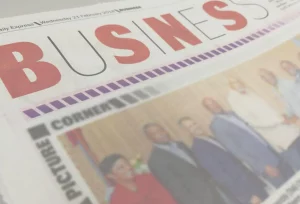Dr Keith Nurse, World Trade Organisation chair at UWI Cave Hill campus, Barbados, says the creative sector could bring healthy returns of $1.8 billion, despite its complexities and challenge of calculating the return on investment.
This figure was gleaned from Nurse’s last estimation in 1995/96, when he estimated the earnings from some aspects of the creative sector at $600 million, with the largest income earner being Carnival.
In an interview with the Business Guardian last week Thursday following the creative industry stakeholders’ meeting hosted by the T&T Coalition of Services Industry (TTCSI) at Capital Plaza hotel, Wrightson Road, Port-of-Spain, Nurse said, “The sector has grown substantially since 1996 and it’s probably double or triple $600 million, and a big chunk came from festival tourism, so the Carnival season counts for the largest share.”
T&T Carnival generates 700 per cent return on investment, he said.
His comment was prompted by the question among those in creative industries – fashion, film, entertainment – about how to measure a return on investment (ROI) in each sector.
He said it’s not quite accurate for the Government to say it did not receive the return of investment it ought to because information is limited on how much is really earned in the creative economy due to its complexities and multiplier effect.
The creative sector, he said, is a transversal sector, meaning it transverses multiple sector, which makes estimation and attribution tricky.
For example, T&T Carnival is the major source of tourism inflow that falls in the tourism and creative sectors. It’s the creative sector that creates a demand for the people to come and purchase goods and services, such as costumes, steelpan, CDs, etc. So there may be a problem of double counting in sectors, which makes it very difficult to have a good estimate.
How to measure
Nurse explained that ROI in the creative sector cannot be measured in terms of a profit and loss statement, where income is measured against expenses (micro economic impact).
Contrary, he said, the sector generates a lot of macroeconomic impact because of its multiplier effect.
In the case of the T&T Film Company (TTFC), it’s not set up to be a commercial entity because it doesn’t make films, but facilitates film making. It’s a facilitator for foreign companies, which generates significant revenue. Its other role is developmental, helping the film and audio visual sectors produce more quality content and market and distribute that content, Nurse said.
In order to determine if the TTFC is having a positive impact, you need to measure what is the contribution of the on location film and what are the income earners, employment impact from the film and audio visual sector.
CSO playing catch up
Nurse said part of the problem in measuring ROI is the methodology used by the Central Statistical Office (CSO), which does not relate to the structure of the creative sector.
He said CSO is better at counting things. For example, in the agricultural sector, it could determine how many tomatoes were produced and exported.
But when it comes to the creative sector, intellectual property sector, our mechanisms for capturing data on the earnings and production is very weak.
Nurse explained this problem is not limited to T&T because the global economy has shifted to a services and a knowledge and intellectual property sector and the statistical agencies were forced to play catch up.
They are trying, but are really far off the mark and the creative industry most exemplifies the challenge of measuring this new kind of economy.
He said the other aspect of the problem lies with the creative sector, where some players in the industry are often not prepared to collect and collate information.
Nurse said the creative sector in other countries has been able, through their industry associations, to collect data from their membership on their earnings from services and intellectual property and are able to report its findings.
He said until the creative sector gets to that point where its industry associations are stronger and able to relate to their membership in a strategic and sophisticated way, these problems would continue.
Why reinvent the wheel?
Regarding the Government’s initial establishment of the T&T Creative Company, Nurse questioned why it was trying to reinvent the wheel.
In addition to the recommendations made by the expert panel in 2011, Nurse said it’s a culture to shoot from the hip and not make decisions based on sound research, evidence and documentation.
This is not done with the energy sector, manufacturing, agriculture, education or health, but when it comes to the creative sector, we make a lot of assumptions.
The panel proposed a flat model entity that would a be clearing house for government policy and help facilitate a process of harmonisation and alignment, but also play an oversight role.
It would help develop the various industry associations to become more self sustaining. These industry associations would then strengthen the relations with their membership and develop export plans, strategies for boosting employment and an innovation agenda via a partnership with the private and public sector.
The solution is simple: let’s work with existing entities to expand their functionality and deepen their role rather than create another entity with staff. I think that the ideal entity is TTCSI.
TTCSI already has most of the creative sector as members and most of the attributes required of the entity, he said.
He said the sector does not require a top-down approach, but a partnership that TTCSI has with its membership.





